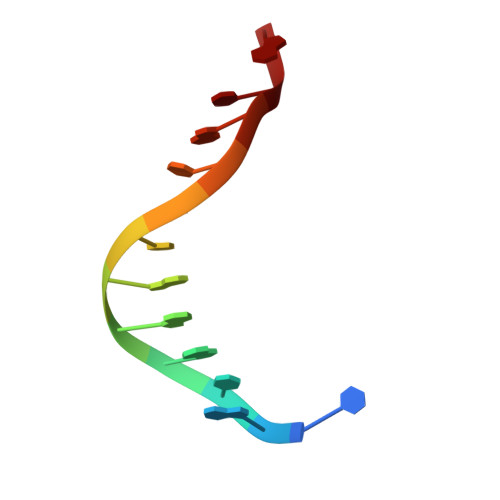Crystallographic Characterization of an Exocyclic DNA Adduct: 3,N4-etheno-2'-deoxycytidine in the Dodecamer 5'-CGCGAATT(ethenoC)GCG-3'
Freisinger, E., Fernandes, A., Grollman, A.P., Kisker, C.F.(2003) J Mol Biol 329: 685-697
- PubMed: 12787670
- DOI: https://doi.org/10.1016/s0022-2836(03)00445-5
- Primary Citation of Related Structures:
1N5C - PubMed Abstract:
Exocyclic DNA adducts are formed from metabolites of chemical carcinogens and have also been detected as endogenous lesions in human DNA. The exocyclic adduct 3,N(4)-etheno-2'-deoxycytidine (epsilon dC), positioned opposite deoxyguanosine in the B-form duplex of the dodecanucleotide d(CGCGAATTepsilonCGCG), has been crystallographically characterized at 1.8A resolution. This self-complementary oligomer crystallizes in space group P3(2)12, containing a single strand in the asymmetric unit. The crystal structure was solved by isomorphous replacement with the corresponding unmodified dodecamer structure. Exposure of both structures to identical crystal packing forces allows a detailed investigation of the influence of the exocyclic base adduct on the overall helical structure and local geometry. Structural changes are limited to the epsilon C:G and adjacent T:A and G:C base-pairs. The standard Watson-Crick base-pairing scheme, retained in the T:A and G:C base-pairs, is blocked by the etheno bridge in the epsilon C:G pair. In its place, a hydrogen bond involving O2 of epsilon C and N1 of G is present. Comparison with an epsilon dC-containing NMR structure confirms the general conformation reported for epsilon C:G, including the hydrogen bonding features. Superposition with the crystal structure of a DNA duplex containing a T:G wobble pair shows similar structural changes imposed by both mismatches. Evaluation of the hydration shell of the duplex with bond valence calculations reveals two sodium ions in the crystal.
Organizational Affiliation:
Department of Pharmacological Sciences, Center for Structural Biology, State University of New York at Stony Brook, Stony Brook, NY 11794-5115, USA.















